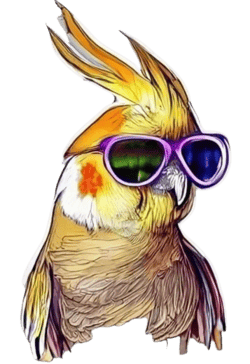How To Clip a Cockatiel’s Wings
Introduction
Cockatiels are wonderful little birds, full of energy and curiosity. There’s nothing quite like the harmonious chirping of your feathered friend as they explore their environment, flitting from spot to spot. However, sometimes, to keep our feathered friends safe, it becomes necessary to clip their wings. This piece is your comprehensive guide to understanding, carrying out, and managing after the wing-clipping process with patience and care.
Background on Cockatiels as Pets
Cockatiels, originating from Australia, are an immensely popular choice for pets across the world, owing to their social nature, vibrant colors, and amusing antics. They are renowned for their intelligence and unique crests – a small bundle of feathers that add to their gracious charm.
The Importance of Wing Clipping
Clipping a cockatiel’s wings is an important part of their grooming routine. This process is akin to having our nails clipped; it’s a painless procedure that helps prevent the bird from flying into dangerous zones like fans, hot stovetops, or out of windows.
To Clip or Not to Clip: Assessing Your Cockatiel’s Needs
It’s important to assess your bird’s needs before committing to wing-clipping. For cockatiels in a safe, controlled environment, with ample space to explore, wing clipping might not be necessary. However, for birds in environments where there might be potential hazards, clipping can be vital to keep them safe.
Understanding the Anatomy of Cockatiel’s Wings
Cockatiel wings are marvels of natural architecture, comprising rows of feathers, each with a specific purpose to assist in flight and grooming activities.
Brief Anatomy Lesson: Feather Types and Functions
The feathers relevant to the wing-clipping process are the primaries — the long, impactful feathers at the edge of each wing. These contribute to lift, speed and directional changes during flight.
Identifying the Flight Feathers: Your Primary Target
Flight feathers are found on the bird’s wings and tail. They are large, strong, and responsible for the bird’s flight capabilities.
Understanding the Issue of Blood Feathers
Blood feathers are the newly growing feathers that still have blood supply to them. Clipping these feathers can cause pain or bleeding, so it’s important to avoid them during the clipping process.
Prepping for the Wing Clipping Process
Assemble the Necessary Tools: What You Need
For safe and efficient wing clipping, gather some sharp scissors or clippers and styptic powder in case of accidental bleeding.
Setting Up a Comfortable and Safe Environment
Choose a quiet, well-lit area for the process. A calm environment can help minimize stress for your bird.
Preparing Your Cockatiel: Calming and Handling Techniques
It’s helpful to familiarize your cockatiel with being held and handled. Gentle strokes and reassuring talk can help keep them calm during the process.
Guided Step-by-Step How To Clip a Cockatiel’s Wings
Detailed Step 1: Holding Your Bird Securely
Gently wrap your hand around your bird’s body, holding their wings securely. Be gentle but firm.
Detailed Step 2: Locating and Trimming the Flight Feathers
Identify the primary flight feathers, and trim in a slow and steady way. Always avoid clipping the ‘blood feathers’.
Detailed Step 3: Ensuring Balance and Testing Their Flight
Clip an even number of feathers on both sides to preserve balance. Test their flight in a secure area to make sure they can glide safely to the ground.
The Aftercare: What to Do Once Your Cockatiel’s Wings are Clipped
Assessing Your Cockatiel Post Clipping: Things to Look Out For
Examine your bird for any signs of distress and give them some time to adjust to their new flying abilities.
Creating a Safe Space for Your Grounded Cockatiel
Make sure their habitat is secure and protected. Add extra perches for easy access to food and water.
Helping Your Cockatiel Adjust: Training and Confidence Building
Work on building your bird’s confidence after the process. Practice target training and stepping up and down from your finger to encourage movement.
Professional Wing Clipping Services and Alternatives
When to Call a Professional: Signs You Shouldn’t Clip Wings Yourself
You should consider professional help if you’re unsure about identifying the right feathers or if your bird is excessively stressed during the process.
Benefits of Professional Wing Clipping Services
Professional services have the experience and know-how to perform the task with accuracy and minimal stress.
Exploring Alternatives to Wing Clipping: Indoor Flight Safety Measures
Covering windows, setting up bird-friendly spaces, and constant supervision can also ensure indoor flying safety for cockatiels without the need for wing clipping.
Conclusion
Summary of Key Points
While wing clipping is a personal decision based on the bird’s environment and behavior, it can provide a pragmatic solution to ensuring your feathered friend’s safety.
Reinforcement of Responsible and Safe Wing Clipping Practices
It’s essential to be patient, caring, and well-informed about the process, and consult a professional when in doubt.
If you’re curious about how big cockatiels can get and what factors influence their size, check out our guide on “How Big Do Cockatiels Get” for more insights.
Frequently Asked Questions about Clipping a Cockatiel’s Wings
Is Clipping Your Cockatiel’s Wings Painful?
No, when done correctly, wing clipping is painless for your cockatiel.
How Often Should I Clip My Cockatiel’s Wings?
The wings should be clipped only as the feathers grow back.
Will My Cockatiel’s Wings Grow Back After Clipping?
Yes, the clipped feathers will be replaced by new ones during the bird’s molting phase.
Caring for cockatiels is a delightful and meaningful commitment. Being informed and considerate about steps like wing clipping demonstrates your love and dedication to your feathery friend. Remember, your cockatiel is a member of your family and deserves all the patience, love and care in this unique grooming process.

About Me
I’m Kamran, a co-founder and content creator at cockatielhq.com. With 8+ years in the world of avian enthusiasts, I’ve gained extensive knowledge in caring for birds. From egg-laying and mating to cohabitation with other birds, dietary needs, nurturing, and breeding, I’m here at cockatielhq.com to share valuable insights for your avian companions.








One Comment